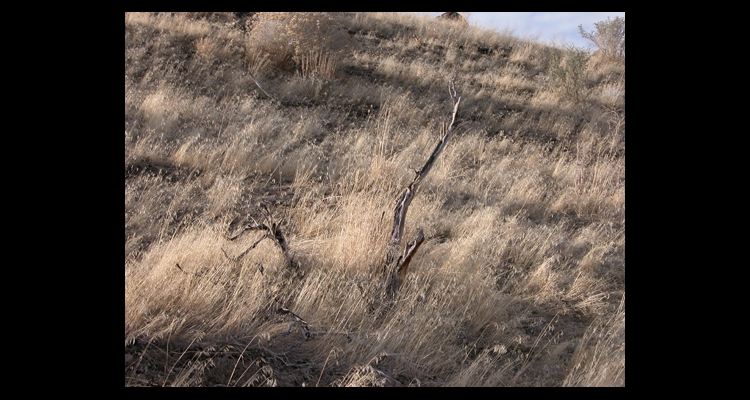Cheatgrass
Overgrazing in the nineteenth century set the stage for the invasion of the exotic grass species, cheatgrass (Bromus tectorum). Native to the Eurasian steppe, cheatgrass has become the dominant vegetation across much of the Intermountain West. This highly flammable species is able to displace native sagebrush-grassland vegetation through facilitation of frequent fires. The relationship between fire and cheatgrass is apparent when driving along Nevada's highways during summer. The golden-brown hue of the low hills and valleys along I-80 indicates cheatgrass-dominated plant communities that have recently burned and stand in dramatic contrast to the darker, fine-textured grain of unburned sagebrush grassland. Cheatgrass is an important contributor to the destructive fires Nevada has experienced over the past decade.
Cheatgrass is able to alter natural fire conditions through its particular life history characteristics. Cheatgrass has a “winter annual” life cycle that differs from that of most native grasses. Seeds germinate in fall or early winter so that established plants grow rapidly in early spring as a result of their “head start.” Abundant seeds are produced and the plant's life cycle is completed in early summer, while native bunchgrasses are still green and not yet reproductively mature. Dry, dead cheatgrass burns readily and produces a continuous layer of fuel to carry range fires. The resulting fires put native vegetation at a disadvantage because many species have not yet set seed. A positive feedback loop is created; with each successive fire, cheatgrass becomes more dominant.
Conversion of sagebrush grassland to cheatgrass is widely recognized as one of Nevada's most serious environmental problems. Cheatgrass provides very little habitat for wildlife and threatens many sensitive species such as the Greater Sage-Grouse and the pygmy rabbit that rely upon sagebrush vegetation for food and shelter. Cheatgrass produces nutritious forage for grazing animals for only a brief time in early spring when it is still green; after that it rapidly becomes unpalatable. The sharp awns (bristles) of its seeds provide a major deterrent to both wild and domestic grazers, as those who have experienced cheatgrass seeds stuck in their socks can readily imagine.
Once established, cheatgrass is very difficult to eradicate. It gradually expands its chokehold on native vegetation even in the absence of fire and can quickly come to dominate areas that have been heavily grazed or have experienced soil disturbance. Furthermore, cheatgrass has been expanding its range southward into the Mojave Desert and to lower elevations while other invasive Bromus species (such as red brome) are expanding their ranges northwards into the Great Basin. Control is possible using a variety of herbicides, but herbicide applications are prohibitively expensive over the large acreages of cheatgrass monoculture and may have adverse environmental effects. Researchers are experimenting with fungal pathogens that could eventually be used as biocontrol agents, for example, Pyrenophora semeniperda, nicknamed the “black fingers of death,” but such treatments are still in the experimental stages.
At present, the best control of cheatgrass may be achieved by range management practices that prevent this species from becoming dominant in the first place. This requires reintroducing native plant species that compete well with cheatgrass, reducing fire risk in areas where cheatgrass is likely to invade, carefully managing livestock grazing and human disturbances such as off-highway vehicle use, and replanting to native species following fire.
Although present in Nevada for little over a century, cheatgrass has become a familiar part of the rangeland landscape. Yet many of our significant environmental problems stem from this exotic species. Cheatgrass poses a huge risk not only to our remaining intact rangeland ecosystems but also to human safety, particularly if climate change portends increased drought and hence more frequent fire.
Article Locations
Related Articles
Further Reading
None at this time.





